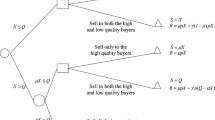Abstract
This paper provides a theoretical explanation for the choice of payment terms under which a company sells its products. In our model, these terms are chosen to permit sellers or buyers to specialize at repairing defects if they are equally well-informed about quality or if one has significantly lower repair costs than the other. Otherwise, the terms are chosen to signal product quality. We also develop the empirical implications of this theory by predicting a seller's choice of payment terms based on the characteristics of its product market.
Similar content being viewed by others
References
Emery, Gary W., “A pure financial explanation for trade credit.” Journal of Financial and Quantitative Analysis 19, 271–285, (1984).
Emery, Gary W., “An optimal financial response to variable demand.” Journal of Financial and Quantitative Analysis 22, 209–225, (1987).
Ferris, J. Stephen, “A transactions theory of trade credit use.” Quarterly Journal of Economics 95, 243–270, (1981)
Lee, Y.W. and J.D. Stowe, “Product risk, asymmetric information, and trade credit.” Journal of Financial and Quantitative Analysis 28, 285–300, (1993).
Meltzer, Allan H., “Mercantile credit, monetary policy, and size of firms.” Review of Economics and Statistics 42, 429–437, (1960).
Mian, Shehzad L. and Clifford W. Smith, Jr., “Accounts receivable management policy: theory and evidence.” Journal of Finance 47, 169–200, (1992).
Rasmusen, Eric, “Games and information: An introduction to game theory.” Basil-Blackwell Publishers, Oxford, 1989.
Schwartz, Robert A., “An economic model of trade credit.” Journal of Financial and Quantitative Analysis 9, 643–657, (1974).
Schwartz, Robert A. and David K. Whitcomb, “Implicit transfers in the extension of trade credit.” In The Channels of Redistribution Through the Financial System: The Grants Economics of Money and Credit (K. Boulding and T. Wilson, Eds.), Praeger, New York, 191–208, 1978.
Smith, Janet, “Trade credit and informational asymmetry.” Journal of Finance 42, 863–872, (1987).
Trachtenberg, Jeffrey A., “Damaged goods: lessons for Campeau: It's not easy being a Chapter 11 retailer.” Wall Street Journal, January 30, 1, (1990).
Author information
Authors and Affiliations
Rights and permissions
About this article
Cite this article
Emery, G., Nayar, N. Product Quality and Payment Policy. Review of Quantitative Finance and Accounting 10, 269–284 (1998). https://doi.org/10.1023/A:1008201701163
Issue Date:
DOI: https://doi.org/10.1023/A:1008201701163




